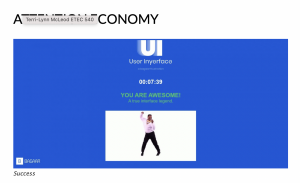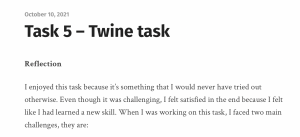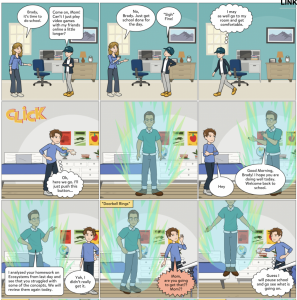ETEC 540 – Linking Assignment
Link 1: Kirn Bhela’s Task 6: An Emoji Story Blog Link: https://blogs.ubc.ca/etec540bhela/2021/10/12/task-6-an-emoji-story/

I was drawn to Kirn’s task 6 because of her connection to accessibility for everyone. Kirn reflects on Bolter’s (2016) arguments of text being seen as superior and visuals as inferior. Kirn (2021) states, “almost anyone with or without an education, can communicate using visuals, however, not everyone can communicate in written text, and if they can, it is generally in only a few languages, not all.” My connection to this statement is my love for visual learning. I have quite a few IEP students in my classes and I always strive to make them feel included and supported. Therefore, I add visuals to almost all of my instructions. If students struggle with textual language, visuals can help make connections to the text.
Kirn spent more time focusing on the plot of the story than I did. I focused mainly on the title of the story and a quick overview of the plot. I picked up the canoe and the carnival of Kirn’s emoji story and immediately made the realization she was describing The Notebook. Each line of her story describes a different scenes of the movie, for example, the line where it details Ally’s family feeling upset about her being with Noah. I appreciate the detail that went into Kirn’s emoji story as it was fairly straightforward to come to a conclusion. Kirn also mentions the connection of theme, text, and visuals. There is the option to view emojis by typing in a common word such as; love or peace. Therefore, Kirn was able to use these themes to select her emojis.
Kirn used Apple Notes to display her emojis. Therefore, she used the Apple emoji keyboard. I also used the Apple emojis, however, I used the emoji platform provided for us in the task description. Kirn uses UBC blogs as her site platform like I do. I believe that she has laid her tasks out well and it was easy to navigate throughout her site.
References:
Bolter, J. D. (2001). Writing space: Computers, hypertext, and the remediation of print(2nd ed.). Mahwah, N.J: Lawrence Erlbaum Associates. doi:10.4324/9781410600110
___________________________________________________________________
Link 2: Terri-Lynn McLeod’s Task 10: Attention Economy Blog Link: https://blogs.ubc.ca/tlmcleodetec540/2021/11/11/attention-economy/

Similar to myself, Terri-Lynn mentions how frustrating this task was. This task tested my patience and like Terri-Lynn, it took me longer than it should have. Terri-Lynn describes the distractions that happened throughout the game like flashing lights and pop-ups. Additionally, Terri-Lynn highlights how her brain has been trained to look for the exit button in the top right corner of the screen, whereas this activity had a close button hidden in the bottom left corner.
What really drew me into Terri-Lynn’s post was her idea of attention. Terri-Lynn mentions that due to the additional boxes requiring your email address, it made her think of how much she clicks on without thinking of it and possibly signing up for something accidentally (2021). This idea differs from mine. I viewed this task as a way to make us frustrated with technology, however, Terri-Lynn addresses the ideas surrounding our impatient habits and assumed conventions. The tool Terri-Lynn uses in this post is textual. There are times where connections to the readings would have been beneficial to her ideas, although she used experience to further describe her thoughts. I appreciate the way she broke her thoughts into different paragraphs. I found this made it easy to navigate throughout the process she was trying to deliver. I too broke my thoughts into paragraphs, however, I feel like I would have benefited from Terri-Lynn’s multiple paragraphs compared to my larger chunked paragraphs.
Terri-Lynn uses UBC Blogs which she has done an excellent job designing her blog to be seamless and easy to navigate. Her blog includes warm colours and easy-to-read fonts. I really appreciate Terri-Lynn’s linking assignment tab. She separates each link into a different drop down bar. This helps separate the information and makes it easy to read. Additionally, Terri-Lynn does this for each task and the final project. The simplicity of Terri-Lynn’s blog makes it inviting and user friendly.
___________________________________________________________________
Link 3: Grant’s Task 8: Golden Record Curation Blog Link: https://blogs.ubc.ca/etec540dgm/2021/10/27/task-8-golden-record-curation/

I chose to do Link 3 to Grant’s Task 8: Golden Record Curation because of his thoughtfulness and breakdown of his song choices. Grant includes several thoughtful ideas about the task and how he managed to pick the songs. Within Grant’s (2021) introduction, he states, “Even though some texts might not seem useful, important, or relevant to today it doesn’t mean that these texts won’t be useful, important, or relevant in the future.” Now that I have read this, I recognize that this statement would have come in handy for me while doing the assignment myself. Grant comments that his initial way of choosing his top 10 songs was listening through them. He mentions an idea that I thought of but wasn’t sure we were supposed to bring up. However, now that I think of it, it truthfully was a large part of the reason I chose my top 10 songs. Grant says his criteria for picking songs was based on musical inclusion, graphical representation, an extraterrestrial perspective, and finally, whether or not he liked the song. To admit my bias, I too chose songs that I liked more than the others. I appreciated Grant mentioning this within his task because I am sure several of us felt the same way. Similar to the way I represented my information, Grant provides a numbered list of his song choices along with a few short sentences of why he chose them. What I wondered most from his selection is whether or not his numbers correlate with how much he liked the song. For example, was his number one pick his favourite song? Was his last pick a quick-pick because he had to add 10?
Grant and I had a few similar selections. For example, we both chose “Johnny B Goode” and “Peru, Wedding Song”. However, “Johnny B Goode” was my first selection and Grant’s sixth selection. I chose this song based on being one of the only songs I truly recognized within the list, whereas Grant chose it based on its instrumental representation. However, similarly, we both mention how it represents the English language quite strongly. I chose “Peru, Wedding Song” as my third choice whereas Grant chose it as his eighth choice. In my post, I write about how this song had a powerful meaning and represented humans’ abilities to have emotions. Grant chose this song because of its significant lack of instruments and being a better choice to represent South America than the alternative options. What I can take from the comparison of our two posts for Task 8 is our musical experience. I believe Grant has more musical experience than I do while comparing his choices. Although we both focus on geographical representation, his ideas of meanings of songs and instrumental representation is much stronger than mine.
Like many of us students in ETEC 540, Grant uses UBC blogs to represent his posts. I believe he has done a good job formulating his site to be user friendly and appealing. Grant ensures that he includes visuals to his tasks and the background of his blog. He has done a good job at providing different links for his tasks and other assignments in the course. After seeing how well he designed and laid out his site, I know my site could benefit from better organization.
___________________________________________________________________
Link 4: A. Trainor’s Task 7: Mode Bending Blog Link: https://blogs.ubc.ca/attexttech540/2021/10/18/task-7-mode-bending/

I chose to do A.Trainor’s Task 7: Mode Bending for my fourth link. I was immediately drawn to Trainor’s video because of the unique perspective she took on the assignment. I appreciated her connection to a course she took on soundscaping, which was inspired by the First People’s Principles of Learning (A. Trainor, 2021). Trainor describes soundscaping as the idea of listening with all of your senses (2021). Trainor did a great job at reinventing the idea of Task 1. The video includes a picture of all of the items in the bag laid neatly beside each other. Throughout the video, Trainor includes recordings of the sounds these items make. For example, there is a noise of keys clanging and a pencil scribbling on paper. I found this idea insanely satisfying and intriguing. Every time there was a new sound, I was drawn back to the image to try and decipher which one it was representing.I felt that this type of video was a great way to engage with your audience and bring attention to the important items within your bag. There were a few items that I was a little confused on, for example, I wasn’t able to identify whether the paper clip or the stick was represented. Overall, it was a fantastic way to engage with different modes. Trainor was able to incorporate auditory and visual modes. However, Trainor also mentions the possibility of a new mode when you are listening with all of your senses (2021).
I also chose to do a video for my mode-bending task. Similar to Trainor, I chose not to use language (my voice) as part of my auditory mode. We both used a type of sound effect to engage our audience, I chose to use music and sound effects, and Trainor chose to use the actual sounds of these items. I think both ways were effective for the context of the assignment.
Trainor uses UBC blogs to represent her tasks and other course assignments. Trainor put a lot of effort into the design of her site, for example, colour coordinating and picking aesthetically pleasing fonts. This differs from mine as I never took the time to try to change any of my fonts. I feared accidentally deleting my site if I played around too much.
___________________________________________________________________
Link 5: Emily’s Task 5: Twine Task Blog Link: https://blogs.ubc.ca/etec540emilychen/2021/10/10/task-5-twine-task/

Emily’s Twine task is very impressive! I absolutely loved the idea she had behind her game. Emily included Chinese characters into her Twine as a way of learning and engaging in culture. The major difference between Emily’s task and my task is that I chose to make a fairly non-engaging Twine as I saw the task as a way to just dip my toes into Twine.
Emily broke down her textual rationale into two challenges she faced. Her first challenge was having no previous experience with Twine. She experienced similar challenges to me through this, such as; not understanding how to do certain effects and having a hard time understanding the coding language. I too had little experience with coding and absolutely no experience using Twine. We both seemed to struggle through this task but both agreed that we were happy with our outcome and learning through the experience. Emily’s second challenge was pointing out that she had little to no gaming experience. Emily felt that she struggled creating a decent narrative to her story, she chose to counteract this struggle by brainstorming ideas on paper first. I believe this really helped Emily as I felt her Twine was engaging and meaningful. I believe Emily could have made some connections to the course readings that week which would have benefited her rationale. However, Emily did a great job at dissecting the challenges she experienced through the task.
Emily chose UBC blogs to manifest her work. Although fairly simple, Emily does a good job organizing her thoughts and her assignments. Emily chose cool tone photos as her background of the site which sets a very professional mood to the site’s aesthetic. One thing I would add to Emily’s task 5 is a visual of somesort. A photo of the introduction of her Twine game may have made her post more appealing. Overall, Emily did a great job representing Task 5.
___________________________________________________________________
Link 6: Tanya’s Task 12: Speculative Futures Blog Link: https://blogs.ubc.ca/etec540groetchen/2021/11/17/task-12-speculative-futures/

I waited to do my final link until task 12 came out. I was really excited to look through my classmates’ different speculatives futures. I wanted to know if we thought of similar ideas or had totally different views of the assignment. Tanya’s task 12: speculative futures assignment really stood out to me.
Tanya’s first speculative narrative was created using Pixton. This is a tool that I have never experienced before, however, after seeing Tanya’s creation through Pixton, it is a tool that would have benefited my own task 12. Tanya highlights how she got the idea from Dunne and Raby (2013) who mention that ideas normally come from a what-if thought. Tanya’s first idea was creating a personalized holographic teacher for her students. Tanya explains how her class has quite a few learning needs, therefore, shadowing the idea that I too created. Tanya and I both seem to be struggling with ensuring those students with additional learning needs are getting the support they need to succeed. Her idea is that each student would get a holographic teacher. This teacher would adapt to the students’ learning environment and be able to meet the needs of the student. From Tanya’s design, I can see that she recognizes that all students have different individual learning needs and she wants to be able to provide her students that type of adaptability. I loved the comic strip presentation as it really brought the idea to life. I could see that Tanya sees a learning environment as an important step in the learning process.
Tanya’s second speculative narrative was made through Animaker. This is another tool that I have never experienced, therefore, going through this assignment has now introduced me to two possible tools I can use in the future. I really appreciated Tanya playing devil’s advocate here. Although Dr. Shannon Vallour (2018) reminds us that AI doesn’t have to be seen as negative, Tanya describes one way that could negatively impact our future generations — decreased social interactions. Tanya uses the Animaker to make an animated video describing something that could potentially happen. The video shows how this “friend” goes through their life without actually having any social interactions, whether their automated robot tells them if they do or not. It describes the loneliness that could come from being so addicted to and reliant on technology. Tanya’s second speculative task humbles us and reminds us to appreciate the in-person socialization we are privileged to.
While comparing my speculative narratives to Tanya’s, we both have ideas about how students and ourselves can benefit from the advancements of AI. However, the major difference between Tanya’s narratives and my own is that Tanya dissects the possible negative impacts that AI could have on our future generations. My post delivers strictly to those who want to see the positive in AI and maybe want to avoid looking down the possible roads it could take us on.
Similar to all of my links, Tanya uses UBC blogs to represent her assignments. I appreciate the way Tanya has organized her different tasks, separating them into labelled links. This makes it easy to navigate and search through her different tasks. Tanya’s site has a consistent clean theme. She includes a panoramic picture of a body of water, presumably in B.C, which represents her love for nature, the land she lives on, and capturing memorable moments. Overall, I really enjoyed reading through Tanya’s speculative narratives and hope we can benefit from the advancements of AI all while understanding the possible negative impacts it may have.
References:
Dunne, A., & Raby, F. (2013). Speculative everything: design, fiction, and social dreaming. MIT press.